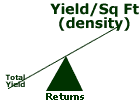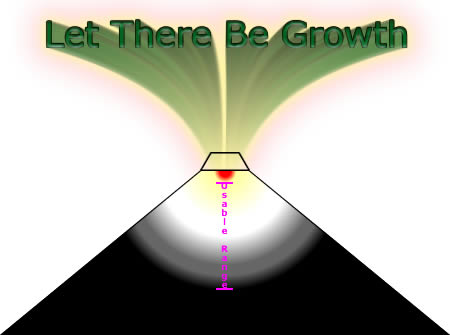
Effects on Growth
The effects on growth from the unavoidable tradeoffs between light intensity and space manifest themselves in the nature
of our harvests. The returns, total yield and yield per square foot (density), are bound to one another
just as light and space are bound. Higher light intensity promotes better
growth and density, but it also promotes a smaller growing space which yields less total weight than a larger space
(in spite of the smaller space having more light intensity). Some growers grow for total yield (density be damned),
some grow for the biggest colas (total yield be damned), but most find a balance between total yield and density
per square foot they can be pleased with.
better
growth and density, but it also promotes a smaller growing space which yields less total weight than a larger space
(in spite of the smaller space having more light intensity). Some growers grow for total yield (density be damned),
some grow for the biggest colas (total yield be damned), but most find a balance between total yield and density
per square foot they can be pleased with.
If a space doesn't give one the total weight he wants, and making the space larger produces more weight but unacceptable density, a lamp upgrade or supplementary lighting would be in order as long as there are no other limiting garden factors at play. Likewise, more lighting may be needed when a space doesn't give one the density he wants, and making the space smaller (to increase light intensity) improves density but produces unacceptable total yield. Unexpected diminishing returns in total yield or yield per square foot are often the case when light intensity or space are taken to extremes. Challenges like this are welcomed by many growers, taken in stride by some, but usually cursed by those with inadequate resources.
The next set of graphics illustrates the effects of lamp height on canopy size, and lamp distance on growth (both vertically and horizontally). It shows the same lamp being used in one of two positions, lower - for a small footprint high-intensity garden, and higher - for a large footprint low-intensity garden.
Notice the lamp's usable range, the distance at which it can produce acceptable growth. Though lamps of different intensities/wattages will have different ranges, because the same lamp is being used throughout these illustrations its usable range here doesn't change. When a lamp is raised to provide for more horizontal growing area it results in a reduction of light intensity to the entire existing area as well as its vertical penetration into the canopy. In other words, the lamp's usable vertical range follows the lamp up when it's raised, and because plants are now more distant than before less of the lamp's usable vertical range is being utilized.
Roll your mouse over the links to |
Effects on Growth From Enlarging An Existing Grow Space |
If JavaScript is disabled or blocked, you need to |
There's dozens of reasons why one scenario would appeal to one person and not another, but matching resources with returns is the prize everyone wants. Resources and returns are no different from other double-edged challenges, they too are linked together, but with the grower serving as the hinge pin he controls the balancing points.
Tail wagging the dog? Roll mouse over image.
As we approach the next page on diminishing returns we've seen that yield per square foot (density) can diminish or rise with changes in light intensity just as total weight can. And though placing an esthetic value on growth (namely colas) is often thought to be an ethereal, illusive or a subjective process (unlike quantifying total yield using a weighing scale), density can be quantified and measured using grams per square foot as the yardstick. Total yield permitting, seldom do growers opt for the hundreds of thumb sized colas produced by a lower density harvest when they have the option to produce fewer but larger colas typical of a higher density harvest. As mentioned before, each grower finds a balance somewhere between total yield and yield per square foot that he can be pleased with.
|
|
|
|
|
|
|
|
Next - |
|
|
|
|
|
|
|
|
|
|
|





